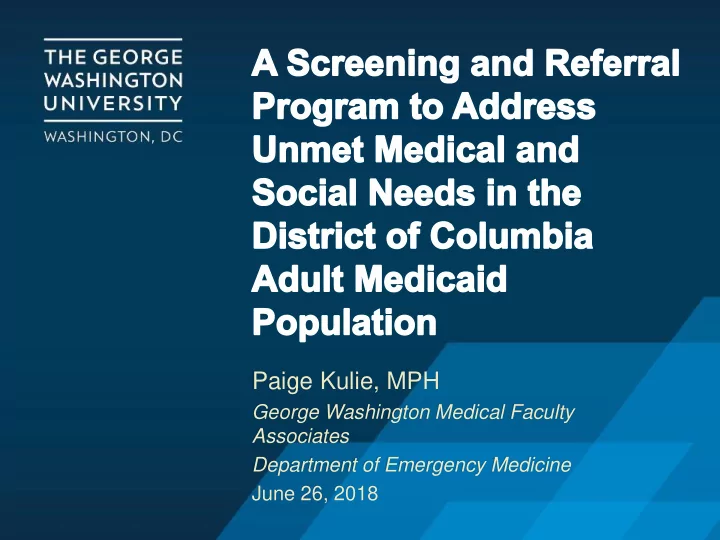

Paige Kulie, MPH George Washington Medical Faculty Associates Department of Emergency Medicine June 26, 2018
Background • Large health inequalities exist within the Medicaid population, largely due to social determinants of health (SDH) • Previous pediatric studies found that SDH screening and referral programs reduce unmet needs, though results are all based on self-report • No study has yet examined a screening and referral system in an emergency department
Objective • To measure the medical and social needs of adult Medicaid beneficiaries during an ED visit and to determine whether referrals to community organizations would result in assistance to address their unmet needs
Methods • We prospectively enrolled 505 ED patients with DC Medicaid at an urban teaching hospital • We administered a survey on sociodemographic characteristics, social risk factors, and medical and social resource needs • We referred subjects to up to three community agencies using an online social services database to address the top three priority needs
Methods • Patients referred to at least one agency were called a month after index ED visit to determine whether they received assistance • Community agencies reported back on patients who received services within three months of referral • Obtained Medicaid claims for one year prior to ED enrollment and used to calculate Chronic Illness & Disability Payment System (CDPS)
Primary Outcomes • To establish the prevalence of various social needs in the adult DC Medicaid population • To determine the proportion of patients referred who contact the referral agency and who ultimately receive a service from the referral agency • To ascertain whether a referral program improved patients’ well -being
Results Distribution of Patient Characteristics by Number of Referrals Characteristic Overall Number of Referrals To Different Organizations 0 1 2 3 TOTAL 505 75 89 117 224 Age 18-34 46% 56% 47% 52% 39% 35-44 15% 16% 13% 15% 16% 44-54 21% 19% 13% 14% 29% ≥55 18% 9% 26% 20% 16% Female 69% 72% 75% 76% 61% Employed (full- or part-time) 57% 68% 69% 54% 50% High school diploma and above 82% 91% 83% 78% 82% Has a usual healthcare provider 73% 79% 78% 74% 68% Living in Poor Housing Conditions 40% 12% 16% 26% 25% Depression/Anxiety 53% 20% 34% 65% 65% Currently Smokes 36% 25% 31% 32% 44% Drinks Alcohol Daily 7% 5% 3% 6% 9% Has someone to help in an 82% 92% 88% 82% 72% emotional crisis Living with children 66% 44% 54% 46% 36% Food Insecure 54% 25% 29% 59% 71% Trouble paying bills in past 12 50% 16% 38% 55% 63% months
Percent of Subjects Who Received Assistance From A Community- Based Organization Service Agency Number Agency Number Reported Referred Reported Completed Receiving Helping Follow Up Agency Help Housing Counseling Services 344 1% 261 11% Food Pantries 149 5% 112 13% Neighborhood Legal Services 73 1% 57 11% Department of Behavioral Health 65 5% 47 9% AmeriHealth (MCO) 63 14% 50 28% Unity Health Care (FQHC) 113 19% 80 8% Medical transport (AmeriHealth) 16 0% 11 9% Our Door (Wellness Center) 52 0% 40 5% Job Training Program 109 0% 78 10%
Multivariate Logistic Regression Models • One: contacted agency • Two: received help • Variables: • CDPS Score • Demographics (age, gender, martial status, children) • Major activity • Social (food insecure, housing stability, paying bills, social support, neighborhood safety) • Medical (depression, substance abuse, smoking) • No significant predictors found
Conclusions • Adult Medicaid patients treated in the ED report a high prevalence of unmet medical and social needs • Relatively few patients followed up and received assistance, regardless of whether measured by self- report or the agency • Passive referrals may not be effective in addressing non-emergency social needs for the low-income population
Previous Studies Author/Year Design Intervention Population Results Gottlieb 2016 RCT Navigator – in clinic and up to 3 Pediatric primary (1) Significant decrease in number of months post and urgent care of 2 social needs in intervention versus safety net hospitals control (2) Significant increase in child’s health reported by caregiver Garg, 2015 Cluster Providers identified and research 8 community health (1) 12 months post-intervention RCT staff made referrals at intervention centers, mothers of greater enrollment in community clinics- RAs also called 1 month post- healthy infants service compared to controls (39% vs 24%) Self-reported outcomes (2) 9 month follow-up, intervention more likely to contact an agency than control (65% vs. 49%) Hassan 2015 Cohort Self-administered, web-based Youth aged 15 – 25 (1) 40% self-reported contacting screening tool agency; (2) No difference in problem resolution between those who contacted agency and those who did not Garg 2007 RCT We Care survey and residents made Pediatric clinic, (1) 20% of those referred in referrals parents of children intervention group reported 2-10 years old contacting agency vs 2% in control group 1 month post enrollment – self-report Fleegler 2007 Cohort Asked parents about needs; if they 2 pediatric clinics, (1) 70% of those screened given ≥ 1 had a need whether anyone in past parents of 0-6 year referral year had referred them to an agency; olds if they had, did they contact the agency
Recommend
More recommend